Campus Housing: Back to Basics
- By Shannon O'Connor
- 04/01/19
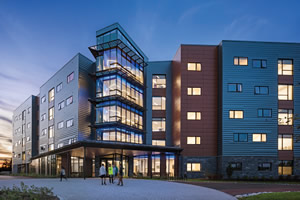
PHOTO COURTESY OF MACKEY MITCHELL ARCHITECTS
Much has been written in the past decade about the “amenities arms race” in campus housing facilities, as colleges and universities increased the wow factor of residence halls in order to aid in recruiting and retaining students. Adding swimming pools, cable TV, movie theaters, housekeeping services, high-end furnishings, and more in order to create luxury hotel-like spaces made good first impressions on potential students and their families, but all these add-ons came at a financial cost, both to the institutions as well as the students themselves.
The amenities arms race appears to be slowing down as enrollment has also slowed, and more students who are looking for economy rather than luxury are turning to less-expensive off-campus living spaces. Also, those living on campus are more cost-conscious and focused on the features of housing that matter most to them—most notably privacy and WiFi—and are willing to settle for fewer frills if their room comes with a lower price tag.
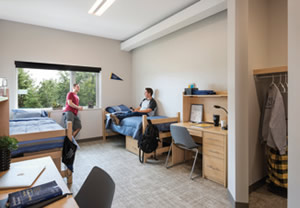
PHOTO COURTESY OF MACKEY MITCHELL ARCHITECTS
Jordan Gatewood, AIA, LEED-BD+C, principal for Mackey Mitchell Architects in St. Louis, confirms this trend.
“The new generation of students (and their parents) are more value-driven because they have lived through the Great Recession,” he says. “These students are said to be more practical and more risk-averse in their decision making. Couple that with the increasing costs of higher education; it doesn’t bode well for overly amenitized housing projects, which typically come with a high rent.”
With these trends noted what is it, then, that today’s students want—or more likely, expect—in a residence hall?
According to a majority of this year’s CP&M survey respondents, the top two expectations incoming students have for on-campus housing is privacy and the very best WiFi. “Privacy,” “private rooms,” and “private bathrooms” were mentioned far more often than safety, low/reasonable cost, or modern amenities. Despite a trend in recent years for the inclusion of community spaces to encourage social interaction, shared learning, and collaboration in residence halls, the perception is that students want to and expect to be alone (with their web-connected devices). One survey respondent summed it by observing that incoming students expect “separation from real people, access to Internet.”
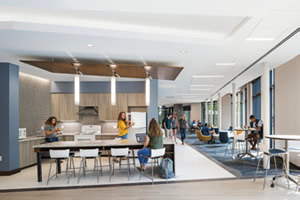
PHOTO COURTESY OF MACKEY MITCHELL ARCHITECTS
Gatewood sees this as well. “Almost all the institutions we are working with express a need for more single-bedroom units,” he confirms. “Singles are desirable for sophomores who may want to remain on campus or are required to live on campus, as many schools are implementing two-year live-on policies. Single bedrooms are attractive for the increased privacy, but singles are also in demand for students who may have physical, social, and/or emotional needs where a single is most appropriate. We will typically now include at least a couple single bedrooms with private bathrooms for this reason,” he says.
THE SURVEY SAYS
Our survey respondents made it clear what the main issues are that concern them in regard to their campus housing. A majority cited aging facilities, deferred maintenance, and the funding required to solve these problems. While students (and their parents) expect a secure, home-like abode with private bedrooms and bathrooms, top-notch WiFi, and overall comfort and safety for reasonable cost, housing administrators are concerned with leaking roofs, obsolete HVAC equipment, worn flooring and, increasingly, the presence of emotional support/comfort animals and the problems they can bring into residential spaces.
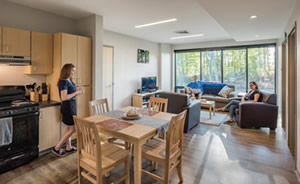
PHOTO COURTESY OF MACKEY MITCHELL ARCHITECTS
Housing programs continue to walk a narrow line between keeping campus building stock functional, comfortable, clean, and safe on tight budgets while students and parents expect more.
With that observation made, what do our survey respondents have to say about the state of their campus housing stock, as well as the students living within it?
SPACE. TOO MUCH? TOO LITTLE? JUST ENOUGH?
The number of students enrolling in higher education decreased a relatively small amount between 2010 and 2016, according to the National Center for Education Statistics (NCES), but is now predicted to increase through 2027. In fall 2016, total undergraduate enrollment in degree-granting postsecondary institutions was 16.9 million students, an increase of 28 percent from 2000, when enrollment was 13.2 million students, according to the NCES. While total undergraduate enrollment increased by 37 percent between 2000 and 2010 (from 13.2 million to 18.1 million students), enrollment decreased by 7 percent between 2010 and 2016 (from 18.1 million to 16.9 million students). The NCES projects that undergraduate enrollment will increase only by 3 percent (from 16.9 million to 17.4 million students) between 2016 and 2027.
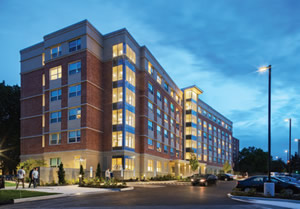
PHOTO COURTESY OF MACKEY MITCHELL ARCHITECTS
Recruiting and retaining students are vital aspects of attracting students to a residential campus, and housing is a marketing tool for institutions looking to draw students to and keep them living on campus. Schools must offer sufficient beds and associated amenities. Too much real estate tied up in residence halls that are under-occupied is a drain on budgets and resources, but a lack of sufficient space for potential and current students might cause those students to instead enroll in an institution that can meet their desires as well as their needs. Are there sufficient beds available today?
Answers to our 2018 survey of housing administrators showed that 59 percent of respondents felt they had sufficient space available; 32 percent indicated too little; and 9 percent indicated they have too much, resulting in unfilled beds. This year, the number of respondents indicating they have sufficient space dropped slightly to 55 percent; 32 percent indicated they have too little (the same as in 2018); and an increase to 12 percent say they have too much.
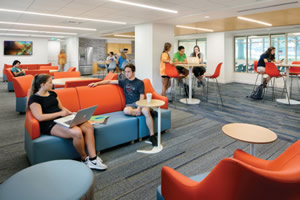
PHOTO COURTESY OF MACKEY MITCHELL ARCHITECTS
Up 7 percent from last year, 85 percent said they are not planning to add any new residence halls to campus in 2019-2020. A decline from the 22 percent reported in 2018, only 15 percent said they are planning to open new residence halls in 2019-2020. Of those 15 percent adding to their stock, over half of survey respondents, 57 percent, are doing so to increase the number of beds available. Thirty-seven percent (up 2 percent from 2018) are replacing existing facilities. Forty-three percent (also up 2 percent from 2018) intend for these new facilities to improve their school’s marketability/help with recruiting new students, while 24 percent—a 7 percent drop from 2018—are opening new facilities in order to keep current students living on campus.
In 2018, 25 percent of respondents indicated that the new facilities underway were intended to create specialized living/learning communities (for first-generation students, or family housing space, to cluster students who are enrolled in similar programs together, etc.). For the 2019 respondents this goal increased only slightly: 28 percent indicated that their new residence halls are creating specialized living/learning communities.
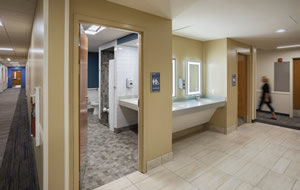
PHOTO COURTESY OF MACKEY MITCHELL ARCHITECTS
Gatewood sees recruitment and retention of students as an important part of the decision to build new facilities. “The majority of new residence halls are being built to replace old facilities or to support enrollment growth,” he says, “That said, we do see many schools using new residential facilities to help achieve strategic objectives such as attracting and retaining students. Furthermore, many schools are implementing (or evaluating the idea of) two-year residency requirements primarily to bolster retention. A two-year live-on policy can mean that more students will need to be housed on campus than current capacity allows. This often translates to needing new facilities or potentially deep renovations to make existing facilities acceptable to sophomore’s and their unique needs.”
Again this year, CP&M asked respondents who are developing, building, and funding new residence halls if their institution had entered into a public-private partnership (P3) with a developer or other entity in order to build and/or maintain these new residential facilities. In 2018, 23 percent indicated they have done so; 77 percent have not. This year, 82 percent respondents said they have not entered into a P3 in order to add or maintain housing; 18 percent indicated that they have. Is Gatewood seeing this trend as well?
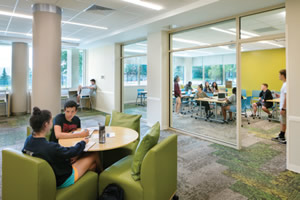
PHOTO COURTESY OF MACKEY MITCHELL ARCHITECTS
“Quite the opposite,” he says. “We are seeing just as many, if not more, projects coming out as P3, and especially large projects. Institutions are turning to P3 for myriad reasons. As many institutions find themselves with limited state funding, significant enrollment growth, large amounts of deferred maintenance, or other financial constraints, P3 can be an attractive delivery model.”
MAINTAINING WHAT’S IN PLACE
For those institutions not building new facilities from the ground up, deferred maintenance, along with routine maintenance, renovations, and upgrades are keeping housing administrators increasingly concerned. In 2018, one-quarter of survey respondents indicated that they had renovations in progress, while 11 percent had renovations on hold due to budget constraints. Forty-two percent of respondents had no major renovations planned.
In 2019, the percentage who responded that they currently have renovations underway or beginning soon is just over a third, at 34 percent. The number with projects on hold due to budget constraints increased to 20 percent, while 37 percent have no major renovations/upgrades planned.

Table 1 indicates the types of renovations or upgrades that are underway or planned for the next three to five years. Up slightly from last year’s 90 percent, 96 percent of respondents indicate that general maintenance, painting, and repair are on the agenda. Seventy percent of respondents say carpeting and flooring replacements are necessary or in the works—the same as in 2018—and 69 percent are planning or are undertaking furniture and fixtures replacement (down from 75 percent last year). The general consensus is that students are hard on housing; keeping up appearances with general/routine maintenance of walls, floors, furniture, and fixtures is a vital minimum to keep residence hall spaces safe, functional, and appealing to new and returning occupants.
WHAT’S IN A RESIDENCE HALL? WHAT SHOULD BE?
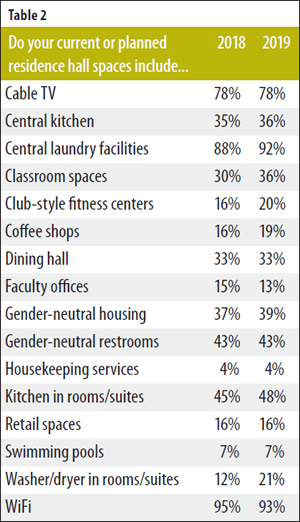 Our survey respondents consistently indicate that students, and their parents, expect residential facilities to provide all the basic comforts and amenities of home… or better than home. What those amenities are can vary; there is no “one size fits all” residence hall. There are, however, common and/or popular amenities that are routinely included or desired across the board.
Our survey respondents consistently indicate that students, and their parents, expect residential facilities to provide all the basic comforts and amenities of home… or better than home. What those amenities are can vary; there is no “one size fits all” residence hall. There are, however, common and/or popular amenities that are routinely included or desired across the board.
In 2018, 88 percent of respondents indicated that their residence hall spaces included central laundry facilities. This year, that number increased to 92 percent. In 2018, 35 percent indicated the existence of full-service central kitchens; this year the number is very similar, at 36 percent. In the spirit of students wanting their own version of amenities, in 2017, survey respondents indicated that 45 percent of residence hall spaces do or will include kitchens in rooms or suites. In 2019, that number increased slightly to 48 percent.
In 2018 and again in 2019, 33 percent of respondents indicated that their residential facilities included dining halls, a number that has held steady for the past several years. As for the presence of the ever-popular coffee shop, in 2018, 16 percent indicated they were or would be included. That number increased to only 19 percent this year.
Classroom spaces were indicated for 30 percent of residential facilities in 2018; that number rose to 36 percent in 2019. CP&M asked again this year if campus residence halls do or will include genderneutral housing. In 2018, 37 percent indicated they do or will. In 2019, that number is 39 percent. Gender-neutral restrooms? In 2018 43 percent, did. In 2019, that number remains steady at 43 percent.
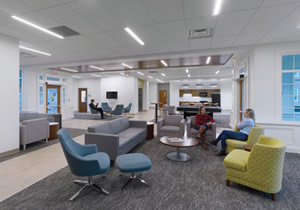
PHOTO COURTESY OF MACKEY MITCHELL ARCHITECTS
It is interesting to note that respondents to the 2017 survey indicated that 49 percent (close to half) of their residence halls included genderneutral housing, and 51 percent included genderneutral restrooms. Perhaps the perception is that “genderneutral” applies to shared spaces, and the desire for and trend towards more private rooms and bathrooms is contributing to these drops in percentages for genderneutral spaces, as privacy doesn’t need to be determined as genderneutral.
“Bathroom privacy in general is always a hot topic,” Gatewood agrees. “Many large state institutions like Penn State and [the] University of Illinois are moving toward all single-user bathrooms in new and renovated halls in lieu of community bathrooms. Single-user bathrooms provide the most flexibility for room assignments and the highest degree of privacy. In the projects where we have community bathrooms there is still the objective of assigning fewer students to the bathroom to increase privacy and to compartmentalize shower rooms and water closets with full-height partitions and as close-to-zero sightlines as possible in order to provide the sense of privacy and security students expect.”
LOOKING FORWARD, WHAT ARE THE CONCERNS?
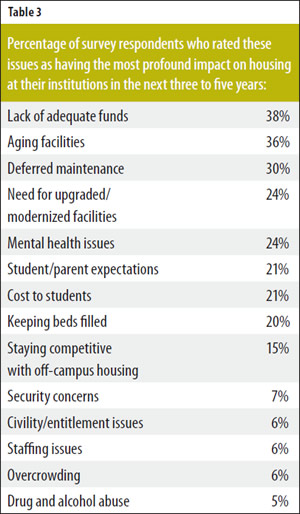 As in previous surveys, the focus of housing directors remains firmly on the struggle to provide adequate safe, functional, up-to-date facilities for their residential students while working with limited budgets and resources.
As in previous surveys, the focus of housing directors remains firmly on the struggle to provide adequate safe, functional, up-to-date facilities for their residential students while working with limited budgets and resources.
When asked to rate the impact of a number of issues on housing at their institutions in the next three to five years, the five issues ranked as having the most profound impact were, in percentage order of concern: lack of adequate funds, aging facilities, deferred maintenance, need for upgraded/modernized facilities, and student/parent expectations, which tied this year with mental/emotional health issues. These are the same top five as 2016, 2017, and 2018. And again, as in previous years (except perhaps for student/parent expectations and mental/emotional health issues), the top four are directly related to financial considerations.
From the same question, the five items most often cited as not having any noticeable impact for the next three to five years are overcrowding, staffing issues, staying competitive with off-campus housing, keeping beds filled, and security concerns.
IT COMES DOWN TO THE STUDENTS
Because providing and maintaining campus housing involves more than creating adequate facilities, we asked our survey respondents what is the one issue that concerns them most right now, and why.
“I am most concerned about the cost to students,” was one response. “Students on financial aid can no longer afford to live on campus…since many of our students come from low-income families with poor credit, they end up having to get private loans to cover part of their costs.”
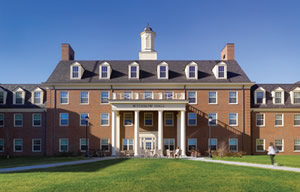
PHOTO COURTESY OF MACKEY MITCHELL ARCHITECTS
“Outside competition of private housing entities with all of their amenities and being able to compete to keep students on campus,” observes another. “Students who stay on campus have a better persistence rate to graduation.”
Budgets, costs, funding, and condition of facilities top the list of concerns again this year. Competition with off-campus facilities concerns some. Keeping upperclassmen on campus was mentioned more often this year, as older—and nontraditional students—are lost to off-campus housing.
An issue mentioned by a surprising number of respondents in this year’s survey is emotional support/comfort animals (ESAs), which are not protected by the Americans With Disabilities Act (ADA). Emotional support animals, comfort animals, and therapy dogs are not service animals under Title II and Title III of the ADA. The Fair Housing Act, however, does require colleges and universities, both public and private, to allow service animals and assistance animals, including ESAs, in campus housing. Students requesting the authorization of an ESA must have been diagnosed with an emotional or mental disorder, and their ESA must be recommended by a doctor. Colleges and universities, therefore, are establishing their own policies on allowing ESAs both on campus and in residential facilities. Even if allowed, animals can bring a new set of problems to living quarters, including damage, cleaning, noise, allergy, and safety concerns. “Some institutions have now designated specific [residence] halls for those with ESAs,” Gatewood says.
A marked increase in marijuana use is also an issue mentioned by a significant number of survey respondents.
And then there are the students themselves.
“Mental health and wellness issues are a significant factor in how we are thinking about programming residential space,” observes one respondent, and this person is not alone. Another respondent adds, “This is a point of concern as to how we can effectively allocate staff, timing, and resources to assist these students while also supporting the community as a whole.” Mental health, emotional health, civility issues, bullying, and even assault and other criminal acts within residential facilities are realistic concerns for a fair number of our survey respondents.
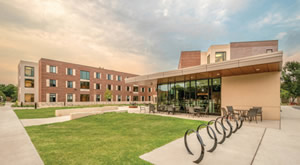
PHOTO COURTESY OF MACKEY MITCHELL ARCHITECTS
According to Gatewood, facility design is responding to concerns surrounding student health; mental, emotional, and physical. “The mental and emotional health concerns have reached crisis levels on many campuses,” he agrees. “Rates of depression, anxiety, stress, and loneliness are all way up. There are many ideas on why the dramatic increases in incidence. From a design perspective, we are talking about wellness early in the process and looking for ways new facilities can improve the well being of residents. A big part of this is using the architecture and program of spaces to support community building among residents; help create that sense of belonging; help students make friends; and help them find resources to support their personal and academic success.”
Looking further into student experience and expectations, what is the biggest change housing experts have seen in their residence halls in the last five years?
The biggest concern is also the biggest change, it seems, as the number of students with mental/emotional health issues and accommodation requirements for them is again frequently mentioned here.
“Students are more selective and have more options than before,” one person responds. “Residence halls integrated with other functional services of the university,” says another. Also, the increasing number of requests for private rooms go hand-in-hand with a shift back to fewer amenities for cost-conscious students (and their parents).
Other concerns: “Technology upgrades, WiFi/network expectations, streaming.” “The cost to build.” “Cheaper construction.” “The financial burden of aging buildings.” “First-year students fear of community-style halls.” “Demand for married housing.” “Lack of resources for capital planning improvements.”
Campus housing directors are on the front lines, working out the balance between student/parent wants and needs; residents’ safety and security; budgets; regulations; what can be accomplished realistically and what cannot; and keeping beds filled in existing facilities that are up and running, attractive, and functional. In the face of these ongoing challenges, they’re also keeping an eye on the bigger picture. “We respond to the changing needs of the new recruit,” explains one respondent.
CP&M would like to thank all who responded to our 2019 survey. The survey data was collected from 201 colleges and universities (169 four-year, 32 two-year; 124 public, 70 private/nonprofit, seven private/for-profit) representing 44 states, the District of Columbia, Puerto Rico, and the Northern Mariana Islands.
This article originally appeared in the College Planning & Management April/May 2019 issue of Spaces4Learning.